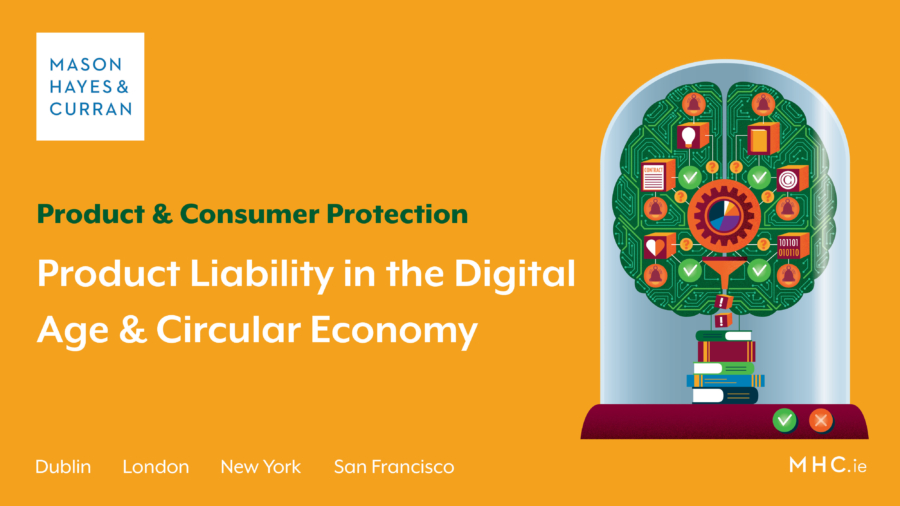
In January this year, the European Commission (the Commission) concluded a public consultation on its proposal to reform the Product Liability Directive 85/374/EEC (the PLD). This consultation followed various reviews of the PLD, including the Commission’s Inception Impact Assessment (IIA) published in June 2021. The Commission’s initiative proposes to adapt the PLD to take account of developments linked to the move towards a circular and digital economy on liability for damage caused by new and refurbished products. It also seeks to address what the Commission perceives as the challenges brought about by Artificial Intelligence (AI). On 6 April 2022, the Commission published a summary report of the findings of its public consultation.
The initiative
The rise of the digital economy is paving the way for a proliferation of AI. In its IIA, the Commission recognised that AI is “benefiting our society and economy but also presents potential risks”. Similarly, the transition to a circular economy, which enables extending the life of materials and upgrading and repairing products and components, benefits the environment. However, the Commission raised concerns around liability for any subsequent damage.
In light of these developments, it highlighted the importance of having a regulatory framework that:
- Provides legal certainty to companies about the risks they take in the course of their business
- Encourages the prevention of damage
- Ensures injured parties are compensated
Gaps in the current liability rules
The existing liability framework consists of the PLD and national liability rules. In the EU, the PLD harmonises one group of claims, namely those against a producer for harm to a consumer due to the defectiveness of a product.
In its IIA, the Commission stated that there are challenges to applying the current liability rules to certain features of digital technologies, including:
- The intangibility of digital products
- Their dependence on data
- Their complexity, and connectivity
- Features specific to AI, such as autonomous behaviour, limited predictability, continuous adaptation, and opacity
This creates legal uncertainty for businesses and may make it difficult for consumers and other injured parties to receive compensation.
The Commission’s objectives, which it is proposed will be achieved through several policy options, are twofold:
- To adapt and modernise strict liability rules to the digital age and circular economy
- To reduce obstacles to receiving compensation for damage under the PLD
Digital age and circular economy: liability rules not fit for purpose
In addition to addressing several shortcomings in relation to the application of the current liability rules to digital technologies, the Commission also observed in its IIA that the digital age has brought about changes to the supply chain. For instance, the rise of online marketplaces, through which consumers can purchase products from outside the EU without an importer. Under the PLD, importers are treated as producers for product liability purposes. In such circumstances, without an importer, consumers are left with no liable person from whom they can seek compensation for damage under the PLD.
Also, the Commission observed that specific characteristics of AI, such as autonomous behaviour, continuous adaptation and limited predictability, make it difficult to get compensation for damages. The extent to which national ‘strict liability’ rules would be interpreted also make it difficult for business stakeholders to understand their liability with sufficient certainty.
Finally, the Commission pointed out that, as liability for defective products is currently determined the moment each product is put into circulation, the current regime does not deal with liability for products which are repaired, refurbished or upgraded, as part of the EU’s drive for sustainability and waste reduction.
Obstacles to obtaining compensation
The Commission noted that complex products, like pharmaceutical or digital products using emerging technologies, can cause difficulty for injured parties in proving defectiveness and causation. This is particularly the case for certain AI products and services, whose specific characteristics could make it difficult and potentially costly for an injured party to prove the necessary elements of their claim.
In its IIA, the Commission stated that this heavy burden of proof could be compounded for injured parties that are disadvantaged by insufficient technical information about AI products and services.
Also on AI products and services, the Commission expressed concern about:
- The risk of national courts applying diverging interpretations of liability rules relating to damage caused by AI, which could create further fragmentation of the liability rules across the EU
- The lack of clarity about whether damage caused by unpredictable outcomes from continuous learning and adaptation in AI-equipped products can be treated as a ‘defect’ under the PLD. The Commission stated that, even if they can be, the PLD’s ‘development risk defence’ would exempt producers from liability for a defect that was not discoverable when the product was put into circulation
The Commission’s public consultation
The Commission indicated that the purpose of the public consultation, specifically, was to:
- Confirm the relevance of the issues it has identified
- Collect information on the need and possible ways to address the specific challenges arising from the uses of AI systems
Results of public consultation on PLD
The Commission published a summary of the outcome of its public consultation on the PLD on 6 April 2022. Overall, this showed a divergence in views between business stakeholders on the one hand and citizens, consumer groups and academic research entities on the other:
- Most members of the public believed consumers should get compensation for intangible digital products which cause damage. In that regard, 95% of citizens, consumer groups and NGOs reported difficulties in claiming compensation for damage caused by technically complex products (such as AI products or pharmaceuticals) due to the challenges of proving defectiveness and causation.
- Generally, business associations and industries mostly supported the possibility of keeping the ‘development risk defence’ unchanged whereas consumer organisations and NGOs favoured revising or removing it.
- 89% of consumer groups, NGOs and citizens agreed that the PLD should cover defective, refurbished or remanufactured products and defective spare parts. This was compared with 55% of business stakeholders.
- 64% of all respondents agreed that consumers should be protected when buying products from online marketplaces outside the EU. Of those, 83% were non-business respondents.
Policy options
A majority of non-business stakeholders supported the Commission’s proposal to adapt the PLD to address these issues, while businesses were less favourable to change:
- Among individual members of the public, 75% agreed that the EU should revise the PLD to address challenges posed by the digital and circular economy.
- In addition, 75% of respondents, excluding individual members of the public, agreed with alleviating the burden of proof for technically complex products by requiring the producer of these goods to disclose technical information and by allowing courts to infer that a product is defective or was the cause of the damage under certain circumstances.
Results on the specific challenges of AI
On the question of legal fragmentation, where EU AI rules are not applied uniformly by Member States, three-quarters of business respondents expected they would need to adapt to AI technology and incur additional costs in the process if Member States adapted AI liability rules in a divergent way.
The vast majority of non-business stakeholders agreed that the specific characteristics of AI make it difficult to link damage caused by highly autonomous AI to the actions of human beings and that this difficulty could hinder the uptake of AI products. Around two-thirds of business stakeholders agreed with this view, but only one-fifth of businesses believed investments in
AI would be abandoned if the current framework is not adapted.
Policy options for AI
Citizens, consumer groups and academic research institutions expressed strong support for:
- Measures regarding disclosure of information and the inference of facts from a refusal by an AI manufacturer to disclose information in the context of a product liability claim
- A presumption of causality where a manufacturer fails to disclose information or comply with safety obligations
- The alleviation of the burden of proof that is imposed on claimants under the PLD in relation to the functioning of AI systems
Business stakeholders showed more diversity in their responses to AI and while they were evenly split on measures regarding the disclosure of information, they were less favourable to:
- Inferring facts from a failure to disclose information, citing intellectual property concerns
- Alleviating the burden of proof currently imposed on claimants or creating any presumption of causality
Non-business respondents strongly supported some harmonisation of strict liability rules in the context of AI products, which could pose a risk of serious injury. Business stakeholders did not in general support this view. Those who did, indicated it was only acceptable in high-risk cases and that clear exceptions should be provided.
Conclusion
The Commission is expected to formally adopt the initiative in the third quarter of 2022, taking a further step towards a proposed Regulation. While business stakeholders may ultimately face increased costs and litigation risk if it is adopted, there is significant support amongst non-business stakeholders for the Commission’s policy initiatives. Also, greater public confidence in technologically complex and AI products could result in greater uptake by consumers and aid legal certainty
across European markets.
Businesses would be wise to engage with and consider these prospective policies as soon as practicable to prepare for these far-reaching changes to EU product liability rules.
For more information, please contact a member of our Product Regulatory team.
The content of this article is provided for information purposes only and does not constitute legal or other advice.







